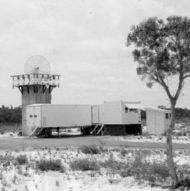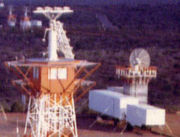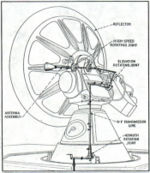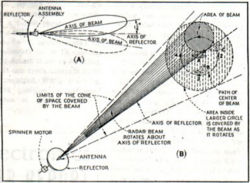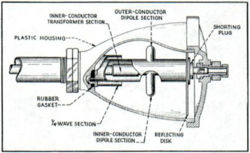VERLORT Radar
| Revision as of 02:57, 6 May 2007 (edit) Paul (Talk | contribs) ← Previous diff |
Revision as of 03:53, 8 May 2007 (edit) Paul (Talk | contribs) Next diff → |
||
| Line 2: | Line 2: | ||
| [[Image:muc-verlort.jpg|right|thumbnail|190px|The VERLORT radar at Muchea:<BR>''Photo - ???'']] | [[Image:muc-verlort.jpg|right|thumbnail|190px|The VERLORT radar at Muchea:<BR>''Photo - ???'']] | ||
| <BR> | <BR> | ||
| - | The '''VER'''y '''LO'''ng '''R'''ange '''T'''racking (VERLORT) radar was an extended-range version of the '''SCR-584''', often credited as "the radar that won WW II". | + | The '''VER'''y '''LO'''ng '''R'''ange '''T'''racking (VERLORT) radar was an extended-range version of the '''SCR-584''', and was often credited as "the radar that won WW II". The range was increased from 650 Km to 4000 Km and the dish diameter from 1.8 m to 3 m to give the radar space tracking capabilities. The Red Lake (Woomera) Mercury tracking station used the more accurate AN/FPS-16 radar installed at Woomera for previous space activities. |
| + | |||
| + | The VERLORT radar performed reliably for the six Mercury orbital missions. It was then relocated to the new Gemini tracking station at Carnarvon as an acquisition aid and back-up for the even more accurate FPQ-6 radar installed there. Although the VERLORT was kept operational for the first few Carnarvon missions it was soon not required because the FPQ-6 was very reliable and other acquisition methods proved sufficient. | ||
| + | |||
| [[Image:cro-verlort.jpg|left|thumbnail|180px|The VERLORT radar reinstalled at Carnarvon just beside the AcqAid antennas:<BR>''Photo - Alan Gilham'']] | [[Image:cro-verlort.jpg|left|thumbnail|180px|The VERLORT radar reinstalled at Carnarvon just beside the AcqAid antennas:<BR>''Photo - Alan Gilham'']] | ||
| The SCR-584, developed at the MIT laboratories, was remarkable for its inventive acquisition features. | The SCR-584, developed at the MIT laboratories, was remarkable for its inventive acquisition features. | ||
| - | |||
| <BR><BR><BR><BR><BR><BR> | <BR><BR><BR><BR><BR><BR> | ||
| - | |||
| ---- | ---- | ||
| - | <BR> [[Image:Conical beam.jpg|right|thumbnail|250px|A conical scan beam: ''Image – ‘Electonics’; Fig 1, Nov ’45, p.104'']] | + | A technically interesting aspect of the VERLORT/SCR family of radars was the innovative solutions to radar operations now met by using electronic computers in modern radars. |
| - | <BR> [[Image:Helical scan.jpg|left|thumbnail|150px|Helical scan mechanism: ''Image – ‘Electonics’; Fig 2, Dec ’45, p.104'']] | + | |
| - | [[Image:offset dipole.jpg|right|thumbnail|250px|Moblas 5 site: ''Image – ‘Electonics’; Fig 5, Dec ’45, p.107'']] | + | The VERLORT Plan Position Indicator (PPI) |
| ---- | ---- | ||
| + | <BR> [[Image:Helical scan.jpg|right|thumbnail|150px|Helical scan mechanism: ''Image – ‘Electronics’; Fig 2, Dec ’45, p.104'']] | ||
| + | |||
| + | <BR> [[Image:Conical beam.jpg|left|thumbnail|250px|A conical scan beam: ''Image – ‘Electronics’; Fig 1, Nov ’45, p.104'']] | ||
| + | |||
| + | [[Image:offset dipole.jpg|right|thumbnail|250px|Moblas-5 site: ''Image – ‘Electronics’; Fig 5, Dec ’45, p.107'']] | ||
| For a detailed technical description of the SCR-584 radar published in the November & December 1945 issues of ‘Electronics’ magazine refer to http://www.hamhud.net/darts/scr584.html. | For a detailed technical description of the SCR-584 radar published in the November & December 1945 issues of ‘Electronics’ magazine refer to http://www.hamhud.net/darts/scr584.html. | ||
Revision as of 03:53, 8 May 2007
SCR-584 Technical Details
SCR-584 Operator Instructions
Back to Muchea
Back to Carnarvon
The VERy LOng Range Tracking (VERLORT) radar was an extended-range version of the SCR-584, and was often credited as "the radar that won WW II". The range was increased from 650 Km to 4000 Km and the dish diameter from 1.8 m to 3 m to give the radar space tracking capabilities. The Red Lake (Woomera) Mercury tracking station used the more accurate AN/FPS-16 radar installed at Woomera for previous space activities.
The VERLORT radar performed reliably for the six Mercury orbital missions. It was then relocated to the new Gemini tracking station at Carnarvon as an acquisition aid and back-up for the even more accurate FPQ-6 radar installed there. Although the VERLORT was kept operational for the first few Carnarvon missions it was soon not required because the FPQ-6 was very reliable and other acquisition methods proved sufficient.
The SCR-584, developed at the MIT laboratories, was remarkable for its inventive acquisition features.
A technically interesting aspect of the VERLORT/SCR family of radars was the innovative solutions to radar operations now met by using electronic computers in modern radars.
The VERLORT Plan Position Indicator (PPI)
For a detailed technical description of the SCR-584 radar published in the November & December 1945 issues of ‘Electronics’ magazine refer to http://www.hamhud.net/darts/scr584.html.
